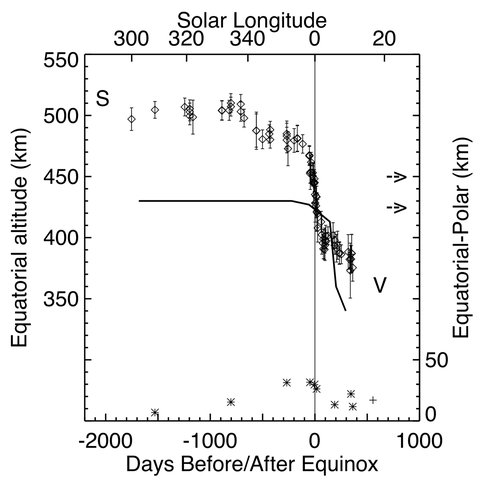2010 Annual Science Report
 NASA Jet Propulsion Laboratory - Titan
Reporting | SEP 2009 – AUG 2010
NASA Jet Propulsion Laboratory - Titan
Reporting | SEP 2009 – AUG 2010
Task 2.1.2.2 Atmospheric Observations
Project Summary
The observed organic haze in the Titan atmosphere is a result of abiotic atmospheric synthesis chemical processes.
Project Progress
Saturn’s moon Titan has a massive atmosphere laden with layers of photochemical haze. Co-Investigator Robert West in collaboration with Postdoctoral Fellow Panayotis Lavvas and others found a recent dramatic change in the vertical structure of this haze, with a persistent ‘detached’ layer dropping in altitude from over 500km to only 380km between 2007 and 2010 (Figure 1). The detached haze layer now appears to be a well-defined tracer for Titan’s meridional stratospheric circulation, models of which suggest that a pole-to-pole Brewer-Dobson cell weakens during equinox as solar heating becomes more symmetric. These measurements connect the Cassini observations with those made by Voyager almost one seasonal cycle earlier. They place detailed constraints on the seasonal circulation, on the sources of photochemical aerosols, on the microphysical processes, and on the complex interplay of these components.
Measurements from Cassini ISS images of the equatorial altitude of the peak brightness of the detached haze are plotted as diamonds with 1-pixel error bars (left ordinate scale). “V” represents Voyager measurements from Rages and Pollack [1983] who found altitudes from 340 +- 10 to 357 +- 5 km over a range of latitudes with the highest value at the equator and the lowest at the pole. “S” shows the altitude of a strong temperature inversion reported by Sicardy et al. [2006] inferred from stellar occultation data. Lavvas et al. [2009] proposed that the inversion is generated by aerosol heating associated with the detached haze layer. Two more temperature inversions were reported by Sicardy et al. [1999] from occultation data obtained in 1989 (3413 days after the 1980 equinox at solar longitude 109°) and are indicated by the arrows. The solid curve is the trajectory of the altitude at the maximum of the detached haze at the equator for the model of Rannou et al. [2002]. Equatorial – polar altitude differences are plotted against the right ordinate scale; the + symbol refers to a measurement by Rages and Pollack. The * symbols are measured from Cassini ISS images.
-
PROJECT INVESTIGATORS:
-
PROJECT MEMBERS:
Robert West
Unspecified Role
-
RELATED OBJECTIVES:
Objective 1.1
Formation and evolution of habitable planets.
Objective 2.2
Outer Solar System exploration
Objective 3.1
Sources of prebiotic materials and catalysts
Objective 3.2
Origins and evolution of functional biomolecules
Objective 3.3
Origins of energy transduction
